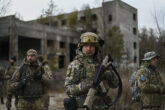March 01, 2024
Ukrainians Are Resilient—But They Still Need Washington
Even as missiles fall on Ukraine and troops brace for a Russian spring offensive from the east, Kyiv is looking west. The U.S. congressional fight over aid to Ukraine, entangled as it is with border policy and presidential politics, has become a matter of survival for 43 million Ukrainians. In more than two years of war, Russian President Vladimir Putin has not broken Ukrainian will. Abandonment by the United States could achieve what Putin never has.
This month, I made a 1300-mile trip around Ukraine as part of a delegation hosted by the U.N. High Commissioner for Refugees (UNHCR). We visited Kyiv and Odesa as well as Dnipro, Kharkiv, and other places farther east. The situation on the ground is changing, and U.S. political leaders should understand the enormous stakes. Those now debating the fate of assistance to Ukraine are deliberating over the fate of Ukraine itself.
The first thing that strikes a visitor to wartime in Ukraine is how remarkably normal life seems in many areas. Normal, that is, until the signs of war creep in—gradually and then suddenly.
Beyond material support, my visit made clear that the psychological effect of global solidarity, especially from the United States, remains vital.
Odesa’s elegantly beautiful theater remains open, and operas and shows go on. (Giuseppe Verdi’s Nabucco and Franco Alfano and Giacomo Puccini’s Turandot played a few days after our visit.) Yet the city was under an air alert as we arrived, and a walk along the seaside promenade revealed coiled barbed wire at each staircase.
In a mostly unheralded success, Ukraine has cleared the Black Sea coast of Russian warships—despite having a tiny navy with no warships of its own—and now exports grain from Odesa at near prewar levels. Ships load grain and skirt the coast as they head west, staying away from Russian predation. Outside the city, soldiers man roadside checkpoints to examine the papers of draft-age men.
In a town that we visited in Kherson Oblast, which suffered under Russian occupation until late 2022, virtually every building was damaged. Missile strikes, mortar fire, and machine guns took a serious toll. Many inhabitants fled the fighting, joining either the 6.5 million Ukrainian refugees outside the country or the 3.7 million displaced inside it. UNHCR and other aid agencies are assisting those who remained and others who have returned. Some never will.
Read the full article from Foreign Policy.
More from CNAS
-
Transatlantic Security / Middle East Security
The Russia-Iran Partnership: A Geopolitical Balancing ActIt has been almost a year since Russia and Iran signed their comprehensive strategic partnership. That deal established a 20-year partnership between the two countries coverin...
By Andrea Kendall-Taylor & Jim Townsend
-
Defense / Transatlantic Security
Ukraine’s Catch-22 MomentThis article was originally published in the Financial Times. In Joseph Heller’s wartime classic, Catch-22, the protagonist Yossarian seeks out the US army surgeon Doc Daneeka...
By Franz-Stefan Gady
-
Transatlantic Security / Middle East Security / Energy, Economics & Security
Sanctions Aren’t Enough to Shut Down the Moscow-Tehran Black Market for WarThe geographic scope and extent of Iranian-Russian cooperation highlights the failure of traditional sanctions to prevent Moscow and Tehran from seeking key components like ch...
By Delaney Soliday
-
What’s Driving President Trump’s New Confidence in Ukraine’s War Effort
President Trump dramatically declared on social media that he now believes that Ukraine can reclaim all its land from Russia, which he described as a paper tiger. From the Ova...
By Richard Fontaine




